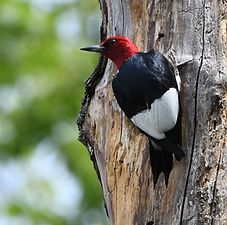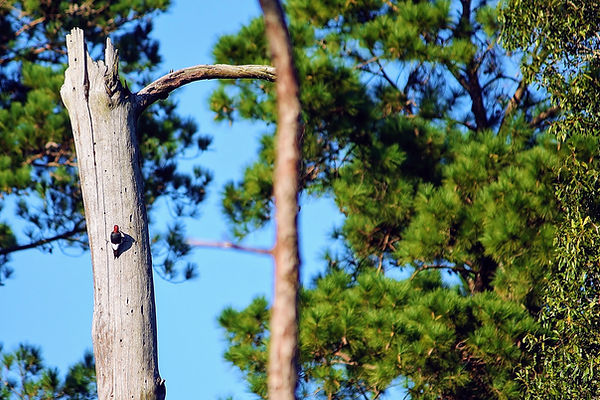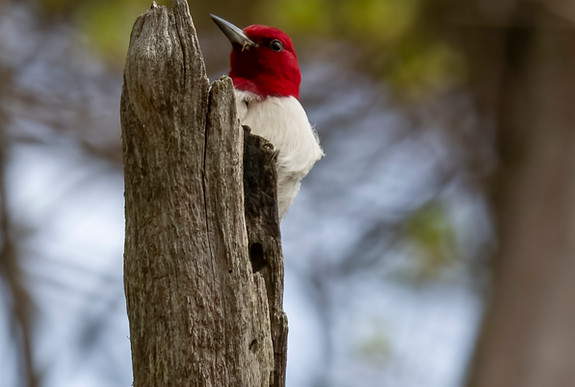
Jim Hudgins/USFWS
The Red-headed Woodpecker is one of the most striking woodpecker species in North America—called by some, the "flying checkerboard".
They are one of only four North American woodpecker species that store food, and the only one who covers their stored food with bark.
In Texas, the Red-headed Woodpecker is most common in East Texas, although their range extends into Central Texas, and the northern Panhandle during the breeding season. View a map of observations on iNaturalist HERE.
Red-headed Woodpeckers are a Species of Greatest Conservation Need in Texas and considered a Common Bird in Steep Decline by the Cornell Lab of Ornithology.
Landowners in Texas can play a key role in supporting this species, whose populations have declined due to habitat loss and changes in forest structure. Here are a couple of important ways landowners can help:
Take action for the Red-headed Woodpecker

Red-headed Woodpeckers thrive in open oak-pine and pine savannahs. ©Rachel Rommel-Crump
1. Protect and restore open oak-pine & pine savannahs
Red-headed Woodpeckers thrive in oak-pine and pine savannahs—open woodlands with scattered, mature trees and little mid-story brush. They avoid dense, closed-canopy forests, preferring places where they can see and fly freely.
Red-headed Woodpeckers are omnivorous, and among the most versatile foragers of any woodpecker species. Unlike other woodpeckers, they are also good at catching insects in the air.
They eat insects—especially beetles, grasshoppers, and caterpillars—as well as hard mast (e.g. acorns, beechnuts), berries and fruit, and occasionally small vertebrates.
They are known for "caching food"—storing acorns or insects in bark crevices for later.
To provide open woodlands and the variety of food sources Red-headed Woodpeckers need, some actions include:
-
Maintaining mature, scattered trees—especially pines and mast-producing trees such as oaks, hickories, and pecans.
-
Thinning dense forested areas to create a more open canopy.
-
Promoting native grasses and forbs beneath trees by reducing dense brush and allowing more light on the ground below.
-
Working with your local wildlife agency or prescribed burn association to use prescribed fire to maintain open forest structure. If fire isn't possible, mow or brush-hog selectively to reduce thick understory.
Contact your county wildlife biologist to create a wildlife habitat management plan for your specific property.

Open, fire-maintained pine savannah in East Texas. Note the abundance of native grasses & forbs. ©Rachel Rommel-Crump

Red-headed Woodpecker in a "snag" (i.e. dead tree). Snags are important for foraging and nesting. ©lwolfartist, CC BY 2.0
2. Leave dead trees ("snags") and dead limbs
Red-headed Woodpeckers need dead trees (i.e. "snags") for nesting and foraging.
They are cavity nesters, meaning they excavate their own nest holes—typically in dead or decaying trees, especially softwoods like pine. Nest height varies, but it's often between 10 and 80 feet above the ground. They may reuse the same snag for several years, either by making new cavities or reusing the old one if still viable.
As noted above, Red-headed Woodpeckers are also one of the few North American woodpeckers that store food. They wedge food—like acorns, nuts, and insects—into crevices of snags or dead limbs, or behind loose bark. These "caches" can be used throughout the year, especially in winter when food is scare.
In colder months or outside of the breeding season, Red-headed Woodpeckers may also use cavities in snags for roosting—staying warm and protected from predators.
Landowners can help provide these critical habitat features for Red-headed Woodpeckers:
-
Unless they pose a safety hazard, leave standing dead trees and dead limbs on living trees. Especially leave dead trees in open areas or with signs of woodpecker use (i.e. holes, bark chips).
-
Avoid removing hollow or decaying trees during the breeding season (April - July).
.jpg)
Red-headed Woodpecker bringing a berry to chicks in their cavity nest. ©Jim Hudgins/USFWS
Red-headed Woodpecker Resources:
- For specific habitat guidance related to your property contact your TPWD wildlife biologist by county HERE.
- Cornell Lab All About Birds Red-headed Woodpecker species profile HERE.
- Texas Breeding Bird Atlas - Red-Headed Woodpecker profile HERE.
- iNaturalist observation map of the Red-headed Woodpecker HERE.
- USDA & USFS Fire Effects Information Systems overview of the Red-headed Woodpecker HERE.

